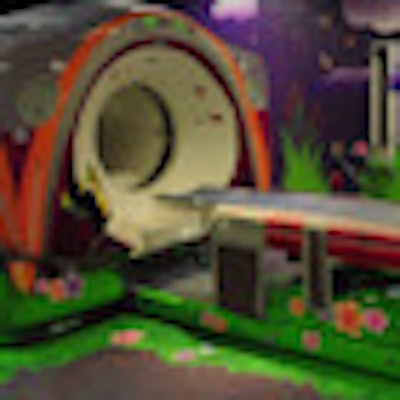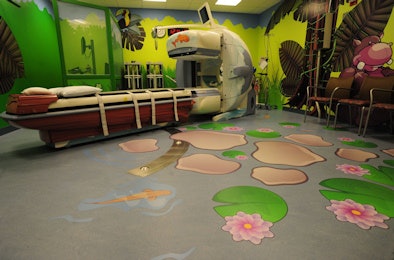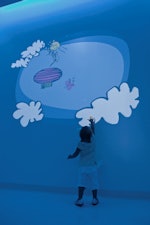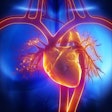
Whimsy and fantasy can do wonders to make hospital experiences less frightening and intimidating for children. Clinical staff benefit as well because the treatment process can be a whole lot easier.
Just ask the radiology team at Children's Hospital of Pittsburgh at the University of Pittsburgh Medical Center. By creating a kid-friendly environment that involves sight, sound, smell, and active participation in the "adventure" by anyone a patient encounters, the radiology department has achieved the remarkable: It has reduced CT scan sedations of pediatric patients as young as age 3 by 99%.
Additionally, Children's Hospital has been handling a steady increase of imaging procedures, now numbering about 180,000 exams a year, without needing to increase its technical and administrative staff, thanks to more rapid patient throughput and improvements in workflow efficiencies. Its themed rooms for emergency and scheduled CT, MRI, PET/CT, and nuclear medicine examinations, and the experiences created in them by radiologic technologists, nurses, child-life specialists, and music therapists, enchant patients to the extent that some even make requests for a repeat exam.
And in Jacksonville, FL, radiology staff members at an outpatient clinic have also found that the use of themed imaging suites is also making a major impact on digital radiography room utilization. The individuals who operate these services at Nemours Children's Clinic are still in the process of collecting formal data, but they shared several anecdotal experiences with AuntMinnie.com.
Avast, matey!
So does wearing a pirate hat and engaging children in an adventure that begins when the patient walks through the door make a difference?
"Most definitely!" said Dana Etzel-Hardman, an advanced practice nurse in Children's Hospital's radiology department. As the training and education specialist, she collaborates with all radiology services on recommendations for the redesign of clinical processes and incorporates them into clinical systems, instructional materials, and service delivery.
The department created a thematic imaging suite -- a "Sea T Scanner" room, replete with fish, coral, and even a near-life-sized mermaid -- in October 2006. They had just purchased a new 64-slice CT scanner (GE Healthcare, Chalfont St. Giles, U.K.) and decided to create a child-friendly experience in the CT suite.
"We were lucky to have a creative registered nurse on staff, Steven Jones, who also had earned academic degrees in both education and television production," she explained.
"We thought that a thematic room would add to the distraction techniques we were using to see if we could increase productivity of the new CT scanner and decrease the number of sedations required for our patients having CT exams," Etzel-Hardman explained.
In the fall 2005, the pediatric radiology department hired a child-life specialist, who had been educating the department's patient care staff and who had direct involvement with children and their families in age-appropriate distraction techniques. The specialist recommended that children be allowed to bring objects, such as blankets or toys, that they would find comforting during an exam. With appropriate radiation protection, parents were allowed to stay in the procedure room with their children. A reward system was implemented to provide children with positive reinforcement during the procedure.
"All this began to pay off dramatically," Kathleen Kapsin, administrative director of radiology, told AuntMinnie.com. "In the fall of 2005, the waiting time to schedule an outpatient CT exam was 16 to 18 days. If we thought that the child might need sedation, the wait time was 29 to 30 days. And if we thought that the child would require general anesthesia, the wait time for the CT scan was 47 to 51 days. Nobody was happy about this."
The effects of distraction techniques, including the "Sea T" room, began to be felt. The number of children requiring sedation for a CT scan declined by 87% in the hospital's 2006 fiscal year compared with 2005. By the end of the 2007 fiscal year, the decline had reached 99%.
"The results were phenomenal," Kapsin said. "I did not expect that this would have such an impact."
The waiting period soon evaporated, enabling same-day or next-day scheduling. And this occurred despite the volume of CT exams increasing by 6.6% in fiscal year 2006 compared with the prior 12 months. Over the next 12 months, the CT exam volume increased another 10.9%, Etzel-Hardman reported.
"Everybody loved the Sea T scan room, even teenagers and occasional adults who had exams performed in it," Kapsin said. "Our executive administrative leadership supported the idea that all of our imaging suites for advanced procedures have themes when we moved into our new hospital in May 2009."
Kapsin and Etzel-Hardman talked with GE Healthcare, the hospital's diagnostic imaging modality vendor. Working with the Children's Hospital radiology team, the Betty Brinn Children's Museum in Milwaukee, and its own creative designers, GE created the GE Adventure Series: decorated procedure rooms and modalities representing themed imaging suites with mascots including an exotic bird, a hippopotamus, a monkey, and a tiger.
 |
| The PET/CT suite, known as "Camp Cozy." Image courtesy of Children's Hospital. |
Pirate Island is a CT suite for scheduled exams. Brown and blue decals on the floor give the impression of a gangplank surrounded by water. Audio tapes generate sounds of the ocean, and olfactory senses are stimulated by a vaporizer giving off the scent of coconut.
The emergency CT suite continues the original Sea T room theme with an underwater yellow submarine and life-sized mermaids. Bubble machines distract injured and distressed patients. "Even big, burly high school football players are glad to be in a nonmedical environment," Kapsin said. "While these aren't the patients we'd sedate, they have a much pleasanter imaging experience in this room."
The PET/CT suite has been transformed into Camp Cozy. It's always night, with dim lights and a starlit sky, replete with stars that move. Natalie Sten, the hospital's current child-life specialist, works with patients before and as they go into the room. A music specialist sings songs to accompany the tiger playing a banjo on the wall, and she encourages children to sing with them. It smells a bit like the forest, and the dusk twitters of birds can be heard. Quite often, patients fall asleep.
A nuclear medicine room is disguised as a jungle -- and also smells like a jungle. Children hear the sounds of animals and rustling grass. With the aid of the child-life specialist and technologists who are engaged in the fantasy, the child enjoys the jungle while staying "safe" on the modality table.
The MRI suite has a space adventure theme. Head coils become space helmets; video goggles become outer space goggles. Children who are able to lie still are told that they are going on a rocket ship, and because the journey is a long one, they will be invited to watch a movie. The children are told that if they fall asleep during the voyage, they'll be awakened at its end.
Kapsin explained that MRI exams require the largest number of patient sedations. But proactive efforts by her team keep these at a minimum. When an MRI exam is to be scheduled, the scheduling staff asks parents if their child can stay still while watching a video program for at least 30 minutes. The patients are welcome to bring their own DVDs. When exams take several hours, not uncommon for a brain MRI and a complete MRI of the spine, the patient will be given a break every 30 minutes.
 |
| The jungle-themed room. Image courtesy of Children's Hospital. |
Sedation is always available, but the need for it has been reduced by 22%, even though procedure volume has increased by 7% since the new hospital opened in May 2009, according to Kapsin.
Sten meets with each patient and parent when they arrive at the department. "My responsibility as a professional child-life specialist is to help children and their families cope with anxiety and fear associated with having a diagnostic imaging procedure. My job is to clear up misconceptions that either the child or adult has. I ask the child what he or she thinks will happen, and then talk with them in a developmentally appropriate way," Sten said.
"With younger children, we do some medical play, in which the patient gets to use 'real' medical equipment -- toy-sized modality models, for example -- with a doll," she said. "This empowers the child with a sense of mastery. We try to give the patient choices so that they feel they are partially in control of the situation."
Sten pointed out that giving a patient a choice in something as minimal as selecting the arm or leg for a blood pressure cuff, and even helping to put it on, can elicit cooperation and compliance from a patient.
Teenaged patients know that they are a bit old to participate in an imaging adventure. But they tend to appreciate what hospital staff members are trying to do for younger children, Kapsin said.
"The radiologic technologists are in tune with them. They may tell the teenaged patient that it's not every day they'll be smelling piña coladas while having a CT scan," Etzel-Hardman explained. She noted that patients enjoyed seeing housekeeping and reception staff wearing pirate hats or other thematic dress as much as the youngest patients.
The suggested cost of a thematic room and adding decorations to a modality is $60,000 to $75,000, according to a GE spokesperson. Kapsin said that although her department and the Children's Hospital have not conducted formal cost analyses, they believe that their investment in creating the imaging room adventures and the salaries of music therapists and the child-life specialist has been very worthwhile on all counts, from a patient/parent satisfaction basis, from staff satisfaction, and from the financial perspective achieved with increased efficiency.
Nemours Children's Clinic
In January 2010, the medical imaging department of Nemours Children's Clinic in Jacksonville, FL, installed the first digital radiography suites in the U.S. with Ambient Experience, a room environment developed by Philips Healthcare of Andover, MA, that creates sound, soothing lights, and visuals for a variety of themes. Each year, the outpatient specialty clinic treats nearly 250,000 patients, and its medical imaging department performs approximately 90,000 exams.
 |
| Image courtesy of Nemours Children's Clinic. |
"There is a sense of curiosity and interest in the room itself that helps keep patients' minds off the actual exams," said pediatric radiologist Debbie Merinbaum, MD, the department's chairperson. "The children feel a sense of empowerment when given the chance to choose their own environment. We've seen that the distraction of the room environment helps reduce patient movement, which can contribute to shorter exam times."
"We treat a significant number of complicated or difficult-to-image patients, such as those with scoliosis or spina bifida," Unger said. "The room creates a difficult-to-describe feeling which distracts the patients. It puts the children at ease, no matter what their age."
Using a touchscreen tablet, the patients or their parents can select one of 10 different themes, including butterflies, scenes of Europe, or rolling hills. Jungle-themed and undersea animation especially appeals to young children, according to Elaine Jenkins, clinical coordinator of medical imaging. Older children can plug in their own music if they don't want the sounds that accompany the images.
"When the child enters the room, it puts them in an environment of not having something done to them, but rather of participating in the exam," Jenkins said. "We tell them that they are going to have fun. And they do. The room environment enables our techs to do exams more rapidly."
As an example, Jenkins cited the case of one patient who regularly has an exam that typically takes an hour to complete. The first time the exam was performed in the new room, the patient fully cooperated, and staff members were able to complete the exam in 20 minutes.
The rooms have created one unanticipated problem.
"Because only two of our five rooms currently offer the environmental experience, our techs only want to use these rooms and vie to do so," Unger said. "Once our repeat orthopedic patients have an exam in the special rooms, they don't want any future exams in the ordinary ones. We schedule the rooms for complex and difficult procedures, and for young and difficult patients who will most benefit from the distracting and novel experiences, but when they are not scheduled, everybody wants to use them."
Will the medical imaging department expand the number of environmental rooms? "We hope so," Unger said. "The benefits to both our patients and our staff are extraordinary."
By Cynthia E. Keen
AuntMinnie.com staff writer
November 12, 2010
Related Reading
Modality models alleviate kids' fears about cancer treatment, October 27, 2009
Kids are kings of the castle at South Dakota hospital, April 22, 2009
Copyright © 2010 AuntMinnie.com



















